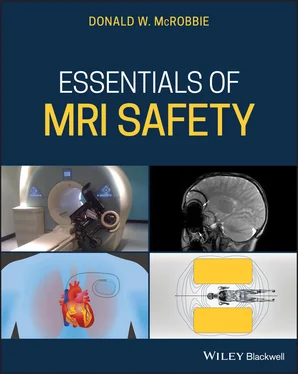Example 2.11 RF wavelength at 1.5 T
What is the RF wavelength in bone, muscle and fat at 64 MHz?
From Equation 2.33, 
ε r values are 16.7, 72.2 and 6.5 – so the wavelenths are 1.12 m for bone, 55 cm for muscle and 1.84 m for fat .
The fields and forces associated with MRI and MRI equipment are not simple. They are all consequences of Maxwell’s equations. Forces on objects may be:
purely magnetic, relating to the shape and ferromagnetism of the material
related to electrical current flowing in the object
related to induction
or movement within a field gradient.
For ferromagnetic objects the attractive or projectile magnetic force is proportional to the spatial gradient of the B 0fringe field. The torque on an unsaturated object is proportional to the square of B 0. Most ferromagnetic objects will be saturated close to the scanner in which case the attractive force is related to B sat .dB/dz and the torque to B sat 2.
Time‐varying magnetic fields from the gradients, RF, or movement within the static fringe field gradient will induce electric fields in tissue. These can lead to the stimulation of excitable tissues or to tissue heating. The RF field can exhibit unpredictable wave‐like behavior. The next three chapters will look at the biological effects of the static field, gradient fields, and RF field.
1 If the magnetic susceptibility χ of a diamagnetic tissue is ‐10−3 the magnetic flux density within that tissue in a 1.5 T scanner will be:1.499 T1.5 T1.501 T1.51 T15 mT
2 The magnetic field strength H at the centre of a long solenoid of length 150 cm, with 1800 turns carrying 1000 A is1000 A m−1200 000 A m−1400 000 A m−1600 000 A m−11 200 000 A m−1
3 The magnetic flux density produced in question 2 is500 G0.5 T1.0 T1.5 T5000 G
4 Which of the following does not affect the magnetic force on a soft ferromagnetic material with a high magnetic susceptibility?The distance to the bore openingThe fringe field spatial gradient dB/dzThe exact value of susceptibility χThe size of the objectIts electrical conductivity.
5 A metal object saturates magnetically at 1 T. The maximum force as it approaches a 3T scanner with a spatial gradient of 5 T m−1 is proportional to1 T2 m−13 T2 m−15 T2 m−19 T2 m−115 T2 m−1
6 When a previously un‐magnetized ferromagnetic object is introduced into an external B field, the maximum torque occurs when the angle between the long axis of the object and the field lines is:0°30°45°60°90°
7 The induced electric field in a circular cross section of tissue from the z‐gradient is proportional to:The tissue conductivityThe area of the cross sectionThe rate of change of magnetic fieldThe radius of the cross sectionTissue density.
8 If the diameter of the heart is 8 cm, what current density would a uniform dB/dt of 100 T s−1 induce in it, assuming tissue conductivity of 0.2 Sm−1?1.6 mA m−2400 mA0.8 A m−20.4 A m−24.0 A m−2
9 If we change field strengths from 1.5T to 3T then (keeping our sequence the same)SAR will stay the same but B1 will halveSAR and B1 will both doubleSAR will double while B1 remains the sameBoth SAR and B1 will increase by four timesSAR will increase by a factor of 4 while B1 remains the same.
10 In a pulse sequence, if we halve the duration of the RF pulse whilst keeping the flip angle and TR the sameSAR will increaseSAR will not changeSAR will decreaseThe duty cycle is doubledWe cannot predict what will happen.
1 1. Schenck, J.F. (2000). Safety of strong static magnetic fields. Journal of Magnetic Resonance Imaging 12:2–19.
2 2. Kaye, G.W.C. and Laby T. H. (1995). Tables of Physical and Chemical Constants and Some Mathematical Functions 16th edn. Harlow, UK: Longman.
3 3. Budinger, T.F. (1979). Thresholds for physiological effects due to RF and magnetic fields used in NMR imaging. IEEE Transactions on Nuclear Science NS‐26:2821–2825.
4 4. Payne, D., Klingenböck, A., and Kuster, N. (2018). IT’IS Database for thermal and electromagnetic parameters of biological tissues, Version 4.0, May 15, 2018. DOI: 10.13099/VIP21000‐04‐0.
5 5. Schaefer, D.J. (2014). Bioeffects of radiofrequency power deposition. In: MRI bioeffects, safety, and patient management (Ed. F.D. Shellock and J.V. Crues III) pp. 131–154. Los Angeles, C: Biomedical Research Publishing Group.
6 6. Hand, J.W. (2008). Modelling the interaction of electromagnetic fields (10 MHz–10 GHz) with the human body: methods and applications. Physics in Medicine and Biology 53:R 243–286.
7 7. Nagy, Z., Oliver‐Taylor A., Kuehne A., et al. (2017). Tx/Rx head coil induces less RF transmit‐related heating than body coil in conductive metallic objects outside the active area of the head coil. Frontiers in Neuroscience 26 January 2017. https://www.frontiersin.org/articles/10.3389/fnins.2017.00015/full
Further reading and resources
1 Kangarlu, A. and Schenck, J.F. (2014). Bioeffects of static magnetic fields. In: MRI bioeffects, safety, and patient management (Ed. F.D. Shellock and J.V. Crues III) pp. 29–63. Los Angeles, CA: Biomedical Research Publishing Group.
2 Panych, L.P. and Madore, B. (2018). The physics of MRI safety. Journal of Magnetic Resonance Imaging 47:28–43.
3 https://itis.swiss/virtual‐population/tissue‐properties/database(Accessed 9 July 2019) Database of tissue properties.
1 1Note, we do not use the term “ferrous” which means “containing iron.”
2 2Sometimes mass susceptibility is used: where ρ is the material's density in kg m–3.
Конец ознакомительного фрагмента.
Текст предоставлен ООО «ЛитРес».
Прочитайте эту книгу целиком, на ЛитРес.
Безопасно оплатить книгу можно банковской картой Visa, MasterCard, Maestro, со счета мобильного телефона, с платежного терминала, в салоне МТС или Связной, через PayPal, WebMoney, Яндекс.Деньги, QIWI Кошелек, бонусными картами или другим удобным Вам способом.













